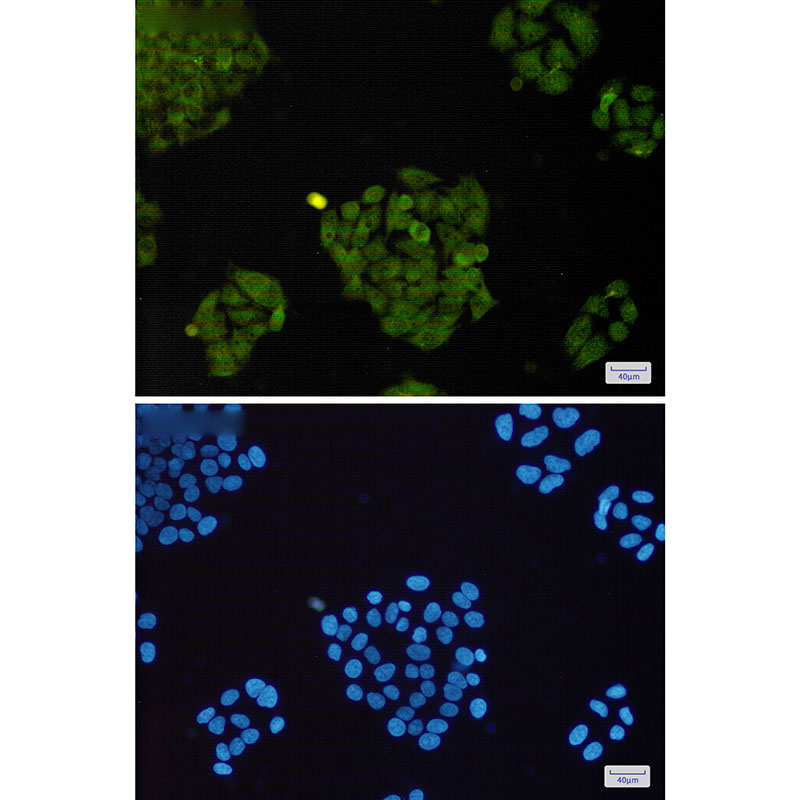BRAT1 Rabbit mAb
- SPECIFICATION
- CITATIONS
- PROTOCOLS
- BACKGROUND

Application
| WB, IP, ICC |
|---|---|
| Primary Accession | Q6PJG6 |
| Reactivity | Human |
| Host | Rabbit |
| Clonality | Monoclonal Antibody |
| Calculated MW | 88119 Da |
| Gene ID | 221927 |
|---|---|
| Other Names | BRAT1 |
| Dilution | WB~~1/500-1/1000 IP~~N/A ICC~~N/A |
| Format | 50mM Tris-Glycine(pH 7.4), 0.15M NaCl, 40%Glycerol, 0.01% sodium azide and 0.05% BSA. |
| Storage | Store at 4°C short term. Aliquot and store at -20°C long term. Avoid freeze/thaw cycles. |
| Name | BRAT1 {ECO:0000303|PubMed:25657994, ECO:0000312|HGNC:HGNC:21701} |
|---|---|
| Function | Component of a multiprotein complex required for the assembly of the RNA endonuclease module of the integrator complex (PubMed:39032489, PubMed:39032490). Associates with INTS9 and INTS11 in the cytoplasm and blocks the active site of INTS11 to inhibit the endonuclease activity of INTS11 before formation of the full integrator complex (PubMed:39032489, PubMed:39032490). Following dissociation of WDR73 of the complex, BRAT1 facilitates the nuclear import of the INTS9-INTS11 heterodimer (PubMed:39032489). In the nucleus, INTS4 is integrated to the INTS9-INTS11 heterodimer and BRAT1 is released from the mature RNA endonuclease module by inositol hexakisphosphate (InsP6) (PubMed:39032489). BRAT1 is also involved in DNA damage response; activates kinases ATM, SMC1A and PRKDC by modulating their phosphorylation status following ionizing radiation (IR) stress (PubMed:16452482, PubMed:22977523). Plays a role in regulating mitochondrial function and cell proliferation (PubMed:25070371). Required for protein stability of MTOR and MTOR-related proteins, and cell cycle progress by growth factors (PubMed:25657994). |
| Cellular Location | Nucleus. Cytoplasm Note=Present at double strand breaks (DSBs)following ionizing radiation treatment. The ubiquitinated form localizes in the nucleus in a NDFIP1- dependent manner. |
| Tissue Location | Ubiquitously expressed. |

Thousands of laboratories across the world have published research that depended on the performance of antibodies from Abcepta to advance their research. Check out links to articles that cite our products in major peer-reviewed journals, organized by research category.
info@abcepta.com, and receive a free "I Love Antibodies" mug.
Provided below are standard protocols that you may find useful for product applications.
If you have used an Abcepta product and would like to share how it has performed, please click on the "Submit Review" button and provide the requested information. Our staff will examine and post your review and contact you if needed.
If you have any additional inquiries please email technical services at tech@abcepta.com.













 Foundational characteristics of cancer include proliferation, angiogenesis, migration, evasion of apoptosis, and cellular immortality. Find key markers for these cellular processes and antibodies to detect them.
Foundational characteristics of cancer include proliferation, angiogenesis, migration, evasion of apoptosis, and cellular immortality. Find key markers for these cellular processes and antibodies to detect them. The SUMOplot™ Analysis Program predicts and scores sumoylation sites in your protein. SUMOylation is a post-translational modification involved in various cellular processes, such as nuclear-cytosolic transport, transcriptional regulation, apoptosis, protein stability, response to stress, and progression through the cell cycle.
The SUMOplot™ Analysis Program predicts and scores sumoylation sites in your protein. SUMOylation is a post-translational modification involved in various cellular processes, such as nuclear-cytosolic transport, transcriptional regulation, apoptosis, protein stability, response to stress, and progression through the cell cycle. The Autophagy Receptor Motif Plotter predicts and scores autophagy receptor binding sites in your protein. Identifying proteins connected to this pathway is critical to understanding the role of autophagy in physiological as well as pathological processes such as development, differentiation, neurodegenerative diseases, stress, infection, and cancer.
The Autophagy Receptor Motif Plotter predicts and scores autophagy receptor binding sites in your protein. Identifying proteins connected to this pathway is critical to understanding the role of autophagy in physiological as well as pathological processes such as development, differentiation, neurodegenerative diseases, stress, infection, and cancer.



